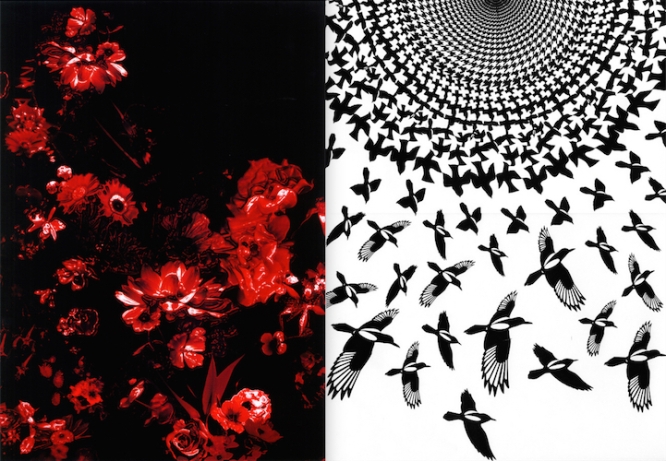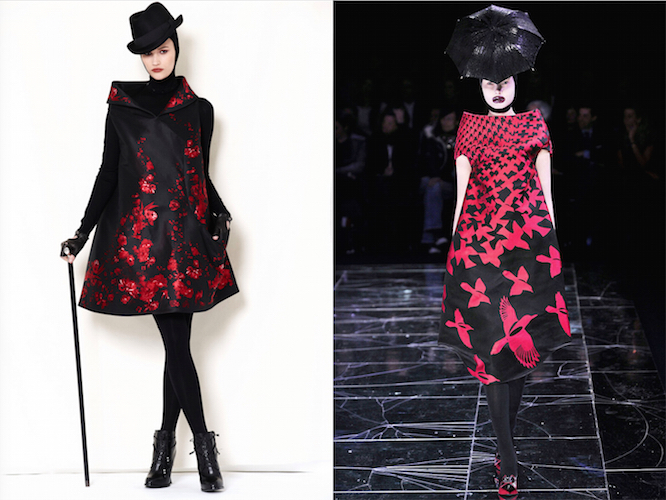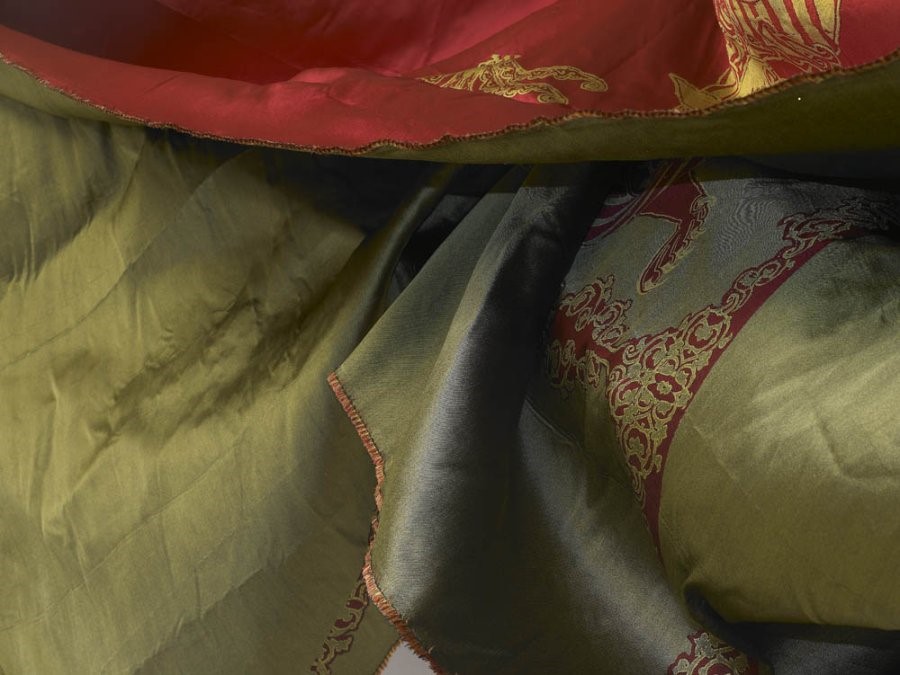
As part of this blog’s celebration of Savage Beauty in London, I’ll be devoting two posts to Alexander McQueen fabrics. (See my earlier roundup post here.) First: a look at McQueen’s distinctive prints.
McQueen’s fellow Central Saint Martins student Simon Ungless, who went on to become director of the School of Fashion at San Francisco’s Academy of Art University, designed the barbed hawthorn print in McQueen’s graduate collection, Jack the Ripper Stalks his Victims (Fall 1992; interview here. Oberto Gili photographed Isabella Blow in the coat for British Vogue.) Ungless also designed the swallow print in The Birds (Spring 1995):


Freelance print designer and Central Saint Martins Textiles tutor Fleet Bigwood designed fabrics for Alexander McQueen’s first three seasons. (See Fleet Bigwood: Breaking the Rules at Texprint, or the BBC’s Blast videos.) The top in this ensemble from Nihilism (Spring 1994, McQueen’s third collection) was printed using an iron filing paste that was rusted through exposure to air and salt water (see Louise Nutt on Pinterest; full collection at the Fashion Spot, or video here):

In 2002, immediately after presenting his award-winning Central Saint Martins graduate collection, Jonathan Saunders was hired to design prints for Alexander McQueen’s Spring 2003 collection, Irere. Working with designer Christopher Pearson—a member of the Alexander McQueen design team from 2001 to 2006 and a founding member of the company’s fashion print department—Saunders produced Irere’s celebrated Bird-of-Paradise prints (see the V&A on Irere):


The following year, Pearson co-designed the Alexander McQueen skull scarf with Jennefer Osterhoudt, who was head of accessories for McQueen at Givenchy and later at Alexander McQueen. The pattern is based on a skull scarf found in Camden Market:

For McQueen’s later collections, the prints were produced by a team of designers that included textile design interns who might be hired back after graduation. From 2006 to 2011, the company’s head print designer was Central Saint Martins graduate Holly Marler, who is now head of embroidery, fabric, and print design at Temperley London.
Lilly Heine, now head of print fabric development at Dries Van Noten, interned with Jonathan Saunders and later Alexander McQueen as a textiles student. (See her profiles in the Frankfurter Allgemeine [German only] and the Independent.) During her internship at Alexander McQueen, Heine designed some prints for La Dame Bleue (Spring 2008). The collection’s rainbow bird-of-paradise print appeared on several looks including the feather-collared Bird of Paradise dress—recently worn by FKA twigs to perform at the V&A’s Savage Beauty gala:

Torunn Myklebust, today a senior print designer at Givenchy, also did a textile design internship at Alexander McQueen. As an intern, Myklebust worked on prints for Natural Dis-Tinction Un-Natural Selection (Spring 2009), and she rejoined the company in late 2009. (Read an interview in Natt&Dag [Norwegian only]; see Myklebust’s tumblr.) The wood-grain digital print from the Spring 2009 collection was later used for the endpapers of Andrew Bolton’s Savage Beauty catalogue:
In her review of the Spring 2009 collection, Sarah Mower identified engineered prints as a trend out of London: “bright, multicolored allover prints, engineered to fit around jackets, leggings, and cocoon dresses—new on the Paris runway, but also part of a general trend emanating from London’s young designers.” The Spring 2009 advertising campaign, shot by Craig McDean, features a jacket and leggings in one of the collection’s crystalline digital prints:

In her Savage Beauty interview with Tim Blanks, Sarah Burton discusses McQueen’s meticulous design process when working with patterned fabrics such as prints or jacquards. From Fall 2009 on, McQueen would drape the initial design using a rough version of the fabric, with the team producing miniature, 3-D paper dolls to show the pattern placement. When a working version of the fabric was ready, he would finalize the pattern placement on a mannequin, after which the print or jacquard would be re-adjusted to match at the seams. Only then would it be sent into production. (See Andrew Bolton, Alexander McQueen: Savage Beauty, pp. 229-30.)
Frederic Alexander, who worked as an assistant to Holly Marler and now designs for his own label, Saint Etienne, worked on prints for Alexander McQueen’s Pre-Fall 2009 and Fall 2009 collections. The Escher-inspired magpie houndstooth print recalls Simon Ungless’ swallow print:


Advances in inkjet technology enabled the thirty-six circle-engineered digital prints in Plato’s Atlantis (Spring 2010). (For further technical discussion of textiles in Plato’s Atlantis, see the Savage Beauty section of the Alexander McQueen website.) Freelance textile designer Chinsky Cheung interned at Alexander McQueen and returned to the company for several collections, including Plato’s Atlantis. In an article published in Hong Kong’s Milk magazine, she shows aspects of the design process including pattern placement:

(For more scans see Augustine Wong’s post, The Queen of the Prints.)

The Fall 2010 menswear (An Bailitheoir Cnámh – the Bone Collector) and women’s Pre-Fall 2010 collection had the same catacombs print:

The textiles in McQueen’s posthumously presented Fall 2010 collection (known as Angels and Demons) were patterned with digitally manipulated images drawn from early religious painting and sculpture. (See Dazed Digital and the V&A on the collection.) Some of the patterns were not prints but jacquards, while the reworked Old Master prints looked back to pieces like the Fall 1997 Campin crucifixion-printed jacket:



For more on digital prints, see the webpage for the Phoenix Art Museum’s 2013 exhibit, Digital Print Fashion (more in Corbin Chamberlin, “Phoenix Art Museum Embraces New Technology with ‘Digital Print Fashion’ Exhibit“). If you’re interested in designing your own digital prints, Kathryn Brenne recently wrote a primer for Vogue Patterns magazine’s February/March 2015 issue, and textbook on the subject, Digital Textile Design (Laurence King, 2nd ed. 2012).
With thanks to Kate Bethune.
Next: Alexander McQueen and tartan.
This is a wonderful post giving so much new and thrilling information. Thank you so much for doing the work, and presenting it beautifully, as ever. Off to the collection again tomorrow night.
Thanks, Kate! Of course I’d love to fly to London to see the exhibit, but I’ll have to content myself with the catalogue..
The Melanie Bowles book is excellent, glad to see it’s had a second edition. Excellent overview of the history, theory, process AND super useful tools for creating designs (how to structure repeats and use common (cough) Adobe tools to achieve good results). Better by far than other books on the topic
Yes, I had the book out of the library when I noticed that the V&A shop has it in their section on books related to McQueen. (link)